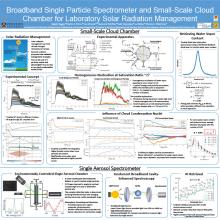Construction of a Broadband Single Particle Spectrometer and Small-Scale Cloud Chamber for Laboratory Solar Radiation Management Experiments
Cole
Sagan
Princeton University
Poster
Solar radiation management strategies offer one solution to prevent the most severe effects from rising global temperatures. One strategy, stratospheric aerosol injection (SAI) purposefully places light-scattering aerosols into the stratosphere to increase the planet’s albedo. Field trials for SAI are not currently realistic. Investigating SAI deployment therefore requires controlled laboratory experiments informing models before moving towards any real climate intervention. For instance, we are still missing experimental data for the wavelength-resolved complex refractive indices of many SAI candidates − key parameters describing aerosol-light interactions. Furthermore, aerosol atmospheric processing, including aggregation, photobleaching, and oxidation, can significantly change the optical absorption and scattering of a given species, but are ignored in most models.
Here, we report on the construction of a single-aerosol chamber that utilizes incoherent broadband cavity-enhanced spectroscopy to acquire light extinction cross-sections of single aerosol subjects over a broad wavelength range. Fitting these extinction cross-sections will grant high-precision wavelength-resolved complex refractive indices. We will use this single-aerosol chamber to study different SAI candidates and investigate how simulated atmospheric processing affects their optical properties. Furthermore, this apparatus will provide a testbed for investigating cloud droplet nucleation and growth on SAI-relevant particles.
In parallel, we have built a small-scale cloud chamber to study droplet nucleation and growth on ensembles of SAI candidates. Particles are loaded into a controlled humidity chamber, which undergoes a rapid expansion, dropping the local temperature and condensing water vapor onto particles. Holographic imaging and phase doppler anemometry retrieve the resulting droplet growth statistics. A tunable infrared laser centered in frequency on a single water vapor transition reveals the evolving water vapor-liquid partitioning in the chamber during droplet growth. Planned experiments will study how turbulence affects droplet growth.
The combination of these facilities will allow a bottom-up approach to better understand aerosol microphysics and inform SAI models.
Here, we report on the construction of a single-aerosol chamber that utilizes incoherent broadband cavity-enhanced spectroscopy to acquire light extinction cross-sections of single aerosol subjects over a broad wavelength range. Fitting these extinction cross-sections will grant high-precision wavelength-resolved complex refractive indices. We will use this single-aerosol chamber to study different SAI candidates and investigate how simulated atmospheric processing affects their optical properties. Furthermore, this apparatus will provide a testbed for investigating cloud droplet nucleation and growth on SAI-relevant particles.
In parallel, we have built a small-scale cloud chamber to study droplet nucleation and growth on ensembles of SAI candidates. Particles are loaded into a controlled humidity chamber, which undergoes a rapid expansion, dropping the local temperature and condensing water vapor onto particles. Holographic imaging and phase doppler anemometry retrieve the resulting droplet growth statistics. A tunable infrared laser centered in frequency on a single water vapor transition reveals the evolving water vapor-liquid partitioning in the chamber during droplet growth. Planned experiments will study how turbulence affects droplet growth.
The combination of these facilities will allow a bottom-up approach to better understand aerosol microphysics and inform SAI models.

Sagan-Cole-poster.pdf
(1.73 MB)
Meeting homepage
